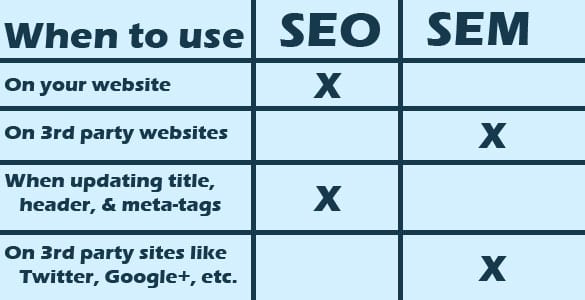Search engines have proven to be a critical means of driving traffic to a website. The last 10 years have seen radical changes in how website owners can help search engines find and rank their content. With all the changes that have taken place, expect more. Lots more.
It’s all too common in the early years of any new industry that terms and definitions get confused.
- Search engine optimization and search engine marketing are two terms that tend to get used interchangeably, but the two terms have very different meanings.
- In fact, the two terms often are argued upon considerably within the online community, with lots of differing opinions on how exactly to define them.
After my own experience in the areas that these two marketing methods cover, I have found my own way for making sense of the two terms. Although, I have come across a few other articles that coincide on some level or another with my explanation of
In this article, I’ll dive into my own interpretation of what each means and show how they’re very different. The biggest difference between the two is WHERE they happen, not so much how. However, do keep in mind that you really can get all of these tasks done without knowing the terms. The most important aspect is to know what should be done first, so I’ll go into the order of importance as well.
Because I like pictures, here’s a high-level overview of the differences:
Search Engine Optimization – Step 1
The very first thing you should do to get your website onto major search engines is to go through a thorough search engine optimization (SEO) phase. Raise My Rank says that
- Titles — including keywords in the title of your web pages.
- Headings — within the content of the page, put keywords in the section headings (H1, H2, H3, etc.).
- Copy/content — use the keywords within the content.
- Address — put the keyword in the actual URL: YourSite.com/keyword-in-the-url.html.
- Meta-tags — comma-separated keywords can help search engines confirm the keywords in the title, headings, and content are legit.
As you can see,
Search Engine Marketing – Steps 2, 3, and Beyond
Just because your website makes it really easy for search engines to understand and track your content does NOT mean you’re going to end up anywhere near the first page of results: the holy grail of search engine traffic. So you have to send signals to search engines that your content is more relevant than anyone else’s. Enter search engine marketing (SEM).
Most agree that
Step 2 – URL Submission
Submit your website to search engine directories. You may want to use a free submission company such as Free Web Submission or you can submit your site yourself using a list such as this one provided by Yahoo. Submitting your URL to directories means that search engines will be much more likely to find your site and crawl it. Need more information on how to index your site? Check out this article on Squidoo.
Step 3 – Building Backlinks
The next step, and one that is quite time-consuming, is to get other websites to link back to yours. Building backlinks is a lot harder than it sounds for two reasons: the links need to be relevant to your web page’s content and some keywords require MASSIVE volumes of link due to heavy competition. Some of the techniques you can use to get these links include:
- Guest blogging — write an article for another site with a link back to your site.
- Content aggregators — write articles on your site and push them to StumbleUpon and other sites that re-publish content.
- Twitter — tweeting with a link (and hopefully getting re-tweeted a BUNCH) works well for link building.
- Google+ — your Google+ pages have dofollow links.
The real key is to make sure that all SEM links are relevant to the content on your page. If you’re running a website about music reviews and you get a link on a page about golf equipment, well, search engines are not going to be able to draw a connection to your content and your keywords. On the other hand, if your SEM link points to a page where you reviewed the recent Rihanna album and the link is on a page about Rihanna and her music, then search engines are going to connect the dots and improve the rank of your page. It’s just that simple, although it does take a LOT of work.
And Beyond – Paid Marketing
Building links is not all that SEM involves, however, and Strategic Ranking is another site that coincides with this statement. Search engine marketing can also involve pay-per-click marketing, other paid ads, and performance reporting and monitoring. Again, for small businesses on a small budget, the paid ads and pay-per-click marketing may not be possible for awhile, at least on a large scale. But the performance reporting and monitoring is a definite step that needs to happen, arguably even before you start building backlinks. Check out Google Analytics for a free way to keep up with the progress of your website’s page rank.
What other techniques are you employing for


